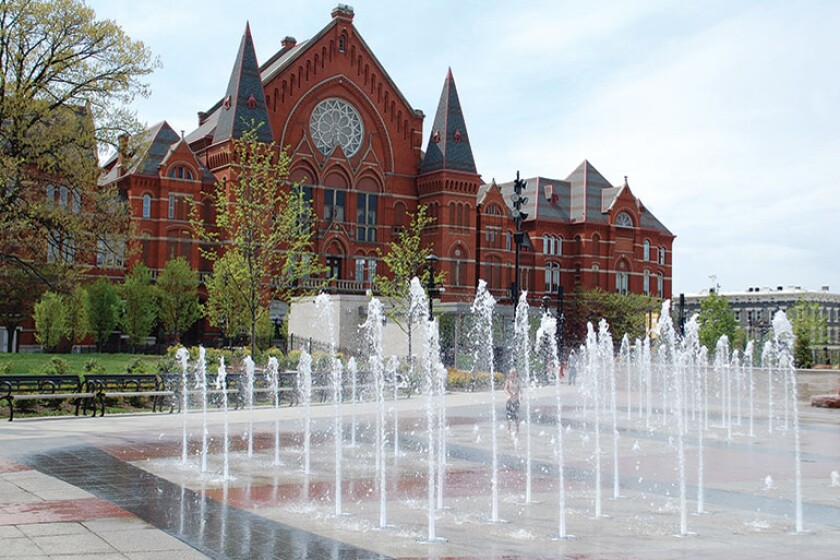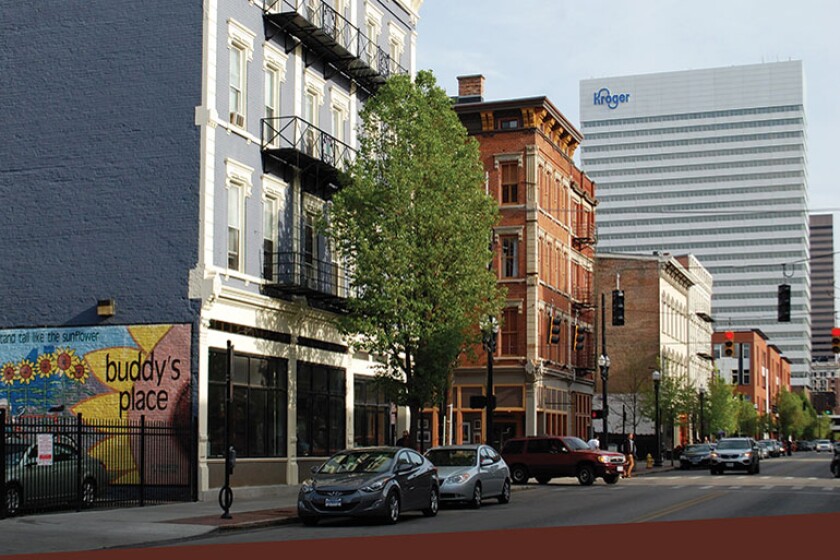The scene is completely different these days. Students from a neighboring arts high school were hanging out on the steps of the park’s bandshell on a recent Thursday afternoon, while city workers set up tables and tents for the weekly “yappy hour” for dogs. Younger kids performed cartwheels or raced down slides on playground equipment made to look like medieval fortresses. “I was there one night with my mother and mother-in-law and thinking to myself that as recently as four years ago, neither one of them would be caught dead in that park, let alone at 10 o’clock at night,” says local attorney Eric Cross.
Washington Park has undergone an $8 million renovation, but that represents a minor facelift compared to what’s been going on in the rest of the neighborhood. Cincinnati’s Over-the-Rhine section, which lies directly north of the city’s downtown, has seen a half-billion dollars’ worth of investment over the past decade, resulting in one of the most remarkable urban transformations of recent times.

The Cincinnati Music Hall serves as a backdrop for Washington Park, which was completely overhauled at a cost of $8 million. (Alan Greenblatt)
Due to earlier population loss, the rehab has avoided the usual arguments about gentrification: There was almost no one to drive out. “We were able to do this because everything was boarded up and hardly anyone was living there,” says City Councilman Chris Seelbach, who lives in the neighborhood. And although Cincinnati’s politics are notoriously parochial, the whole city has embraced Over-the-Rhine’s success. Instead of being seen as a boondoggle only helping out one part of the city, the neighborhood is now viewed as an asset that’s helping the whole city to change both its image and its fortunes.
Like a hopeful suitor, Cincinnati is making itself more attractive to young people who have fled the city in recent times, as well as big corporations. When General Electric recently announced plans to open a $90 million downtown facility that will bring in 1,500 jobs, local officials celebrated it as the latest proof that their strategy of investing in older parts of the city could pay off in a big way. “I can’t remember the last time an employer announced that many jobs,” says Michael Jones, an economist at the University of Cincinnati.
No one would have expected Over-the-Rhine to become a selling point for the city. It was the scene of race riots in 2001, which led Reason magazine to describe the district as “ground zero in inner-city decline.” Actually, the riots simply accelerated the type of decline and disinvestment that had already plagued the area for decades. Just a few years ago, it was considered one of the most dangerous neighborhoods in the country. Now, it’s become a fashionable urban playground. The change has been so rapid that for undergraduates at local colleges, Over-the-Rhine has gone from no-go to must-go in the time they went from being freshmen to seniors. A few blocks of Vine Street have become a major dining destination, with waits for tables sometimes stretching toward the two-hour mark. “When I was in college, I would not go out in downtown Cincinnati,” says Allie Honebrink, who works for the Cincinnati Ballet. “Now when I’m going out with friends, it’s ‘Where in Over-the-Rhine are we going to go?’”
It is not uncommon for neighborhoods to languish for decades before suddenly popping and becoming fashionable seemingly all at once. Many of them boast streets where wig shops and fast-food parlors give way to hip clothing boutiques, raw juice bars and stores selling pricey but uncomfortable-looking furniture. But perhaps nowhere in the country has that transition been as swift as in Over-the-Rhine. “The breadth and the rapidity of the change is so remarkable,” says Mayor John Cranley, “that certainly in Cincinnati it’s the most dramatic and positive urban development in 50 years.”
It’s not stopping. A new streetcar line is knitting Over-the-Rhine together with the central business district as well as the stadiums down by the Ohio River. There’s plenty of room for further development to take advantage both of the new transportation connection and the neighborhood’s recent flowering. In fact, it hardly takes any imagination at all to see which buildings could be spruced up next. In an unusual touch, many empty properties are covered with painted fronts that show how cute and charming they might look once they’ve been rehabbed.

Many of the still-empty century-old architecturally significant properties are covered with painted fronts demonstrating their future potential. (Alan Greenblatt)
But now, with the area having arrived, desirable not only for diners and drinkers but also condo dwellers, some people in Cincinnati are wondering whether it’s time to share the wealth, ending the city subsidies artificially inflating the market and easing back on the dominant role played by the leading development corporation. “Without a heavy hand and a centralized body, it might not have happened at all, but at some point normal market function needs to be resumed,” says Wade Dent, a real estate broker and developer. “There’s a time and a place for subsidy, to stimulate the development of an area, but you’ve got to know when to stop it. And power and greed make it hard for that to happen.”
Over-the-Rhine got its name almost as a joke from the first German settlers who moved to the area, which lay north of a canal that is now a main roadway. “The settlers were pushed out of downtown and over the canal,” Seelbach says. “They founded this neighborhood and really built the structures.” Indeed, with few exceptions, the neighborhood’s building stock -- Queen Anne, Italianate and Greek Revival -- still consists of properties put up by German-Americans between the first wave of their immigration in the 1830s until World War I. “Architecturally, it’s kind of frozen in a moment,” says Mike Morgan, author of the 2010 book Over-the-Rhine: When Beer Was King.
Morgan calls it “one of the largest, most significant urban historic districts in the United States” -- slightly bigger than the French Quarter in New Orleans. Yet the city never seemed to appreciate what it had. Instead, Over-the-Rhine became a dumping ground for the poor, profitable almost exclusively to landlords who got tax credits for sheltering them. “One out of every four units was very low income -- nonworking, welfare-dependent folks,” says Jim Tarbell, a developer and former member of the city council.
What was once one of the densest neighborhoods in the country emptied out. Over-the-Rhine’s population was down to about 7,000 in 2000 -- 96 percent of them renters -- from a high of 50,000. It was a place of rot, with buildings either collapsing into the street or threatening to do so. In 2005, there were nine times as many violent crimes and robberies than the average for other Cincinnati neighborhoods. Morgan compares the area a decade ago to “Hamsterdam,” the fictional section of Baltimore on “The Wire” that police allowed to become an open-air drug market, as long as dealers stayed within its confines. “You could really do anything you wanted,” says Morgan, who says he witnessed one person get killed and others shot in the area. “You could walk down the street with a joint in one hand and a beer in the other and everything was cool, because they wouldn’t arrest you.”
Locals still chafe at the description of the protests that followed the police shooting of an African-American teenager in April 2001 as “riots,” but those several days of unrest, while confined to a few square blocks, did incalculable damage to the neighborhood’s image. “The bad press did more damage than the riot itself,” says Tarbell, who still mourns the fact that CNN was so quick on the scene with its cameras.
But the events also led to some good. For one thing, Cincinnati police made a concerted effort to improve relations with African-Americans. And the top leadership of the city’s major corporations -- Procter & Gamble, Kroger, Fifth Third Bank and Macy’s, among others -- decided they couldn’t tolerate a dysfunctional neighborhood right on the doorstep of downtown. These companies put up millions of dollars to help fund the Cincinnati Center City Development Corp., known as 3CDC. In addition, the city created tax increment financing districts that used property tax dollars from downtown to invest in economic development in Over-the-Rhine. That’s what paid for most of the renovation of Washington Park. “As a clear object lesson for other cities around the country, it’s not like you can wave a magic wand and just say, ‘Well, now we’re a tolerant city and we welcome entrepreneurs and therefore people are just going to show up,’” says Cranley. “No, it took $500 million in investment.”

A $500 million investment, partly paid for by the city's major corporations, made the neighborhood transformation possible. (Alan Greenblatt)
3CDC dominates Over-the-Rhine, rehabbing buildings and handpicking tenants for them -- not just the retailers and restaurateurs, but the law and architecture firms that have come in. The neighborhood, which was marred by hundreds of vacant properties just a few years ago, is now home to a Pilates studio, a shop selling vintage posters and a venture capital firm called The Brandery. The neighborhood, which was a major beer-making center before Prohibition, is seeing a revival of craft brewing, with great old Cincinnati names coming back and a Sam Adams facility nearby. “The breweries in Cincinnati are starting to make a name for themselves downtown, bringing back the history,” says Jack Heekin, co-owner of a new bar in Over-the-Rhine.
3CDC has something akin to a monopoly throughout stretches of the neighborhood; it will decide when and if those pretty painted facades turn into real projects. Meanwhile, the parts of Over-the-Rhine where 3CDC is less active, north of Liberty Street, remain pretty much moribund. “What’s happened is they’ve effectively gotten a monopoly on the market,” says Morgan, the neighborhood historian and activist. “They do things when they want to do them, when it fits their schedule and their bottom line.”
Even Morgan and other critics, though, acknowledge that a neighborhood that was both as challenged and as promising as Over-the-Rhine needed 3CDC, or some entity like it. Its success is clearly attracting activity. Duy Nguyen, who spent part of his childhood
in Cincinnati, always wanted to open a restaurant, but saw little chance of that happening in Over-the-Rhine when he moved there about six years ago. A few people were rehabbing apartments, but there weren’t any retail outlets or restaurants to speak of yet. He planned to move to Chicago or Denver or some other large city, but he was quick to notice and take advantage of the change once it started to happen. “A lot of the people who opened up the businesses three years ago became friends, we all help each other out a little bit,” says Nguyen, who now co-owns a busy restaurant on Vine Street called Quan Hapa that features upscale takes on Asian street food. “We’ve come pretty far in a short amount of time.”
Just a couple of blocks north of his restaurant you’ll find reminders of how derelict Over-the-Rhine used to be. Even in a city riven with rivalries between its 52 neighborhoods and the separate worlds of its east and west sides, everyone recognizes that the development that’s occurred so far has been a success. Not far from Quan Hapa, Gwendolyn Hill still runs, as she has for a decade, what you might describe as a traditional sort of Over-the-Rhine enterprise, selling clothes and cologne from a folding table along the sidewalk. She says she likes what she’s seen. “It needed a change,” she says. “It does some good for the neighborhood, making them want to take care of their property.”









